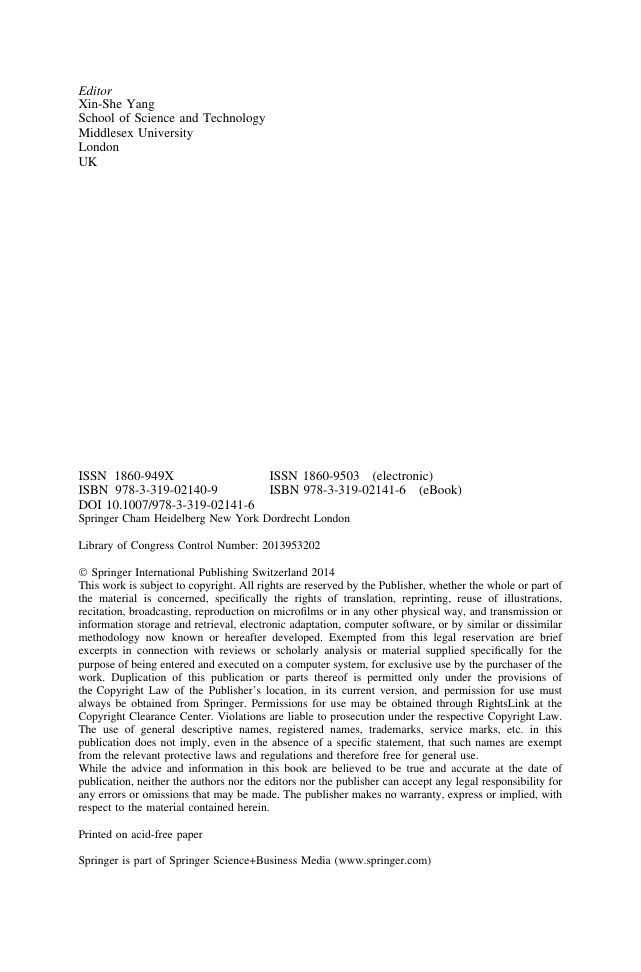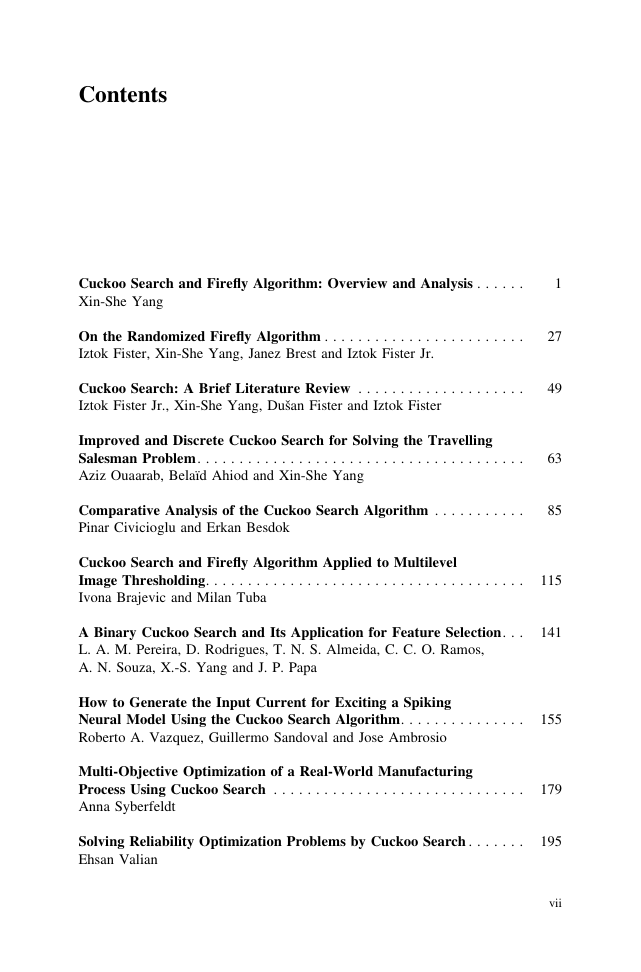Preface
Contents
Contributors
1 Cuckoo Search and Firefly Algorithm: Overview and Analysis
1 Introduction
2 Optimization Problems
3 The Essence of an Optimization Algorithm
3.1 The Essence of an Algorithm
3.2 An Ideal Algorithm?
3.3 Metaheuristic Algorithms
4 Cuckoo Search and Analysis
4.1 Cuckoo Search
4.2 Special Cases of Cuckoo Search
4.3 Why Cuckoo Search is so Efficient?
4.4 Global Convergence: Brief Mathematical Analysis
4.5 Applications
5 Firefly Algorithm and Analysis
5.1 Firefly Algorithm
5.2 Parameter Settings
5.3 Algorithm Complexity
5.4 Special Cases of FA
5.5 Variants of Firefly Algorithm
5.6 Attraction and Diffusion
5.7 Why SA is Efficient
5.8 Applications
6 Right Amount of Randomization
6.1 How to do Random Walks
6.2 Accuracy and Number of Iterations
7 Parameter Tuning and Parameter Control
7.1 Parameter Tuning
7.2 Parameter Control
8 Discussions and Concluding Remarks
References
2 On the Randomized Firefly Algorithm
1 Introduction
2 Background Information
2.1 Uniform Distribution
2.2 Normal or Gaussian Distribution
2.3 Lévy Flights
2.4 Chaotic Maps
2.5 Random Sampling in Turbulent Fractal Cloud
3 Randomized Firefly Algorithms
3.1 Original Firefly Algorithm
3.2 Variants of the Randomized Firefly Algorithm
4 Experiments and Results
4.1 Test Suite
4.2 Experimental Setup
4.3 PC Configuration
4.4 Results
5 Conclusion
References
3 Cuckoo Search: A Brief Literature Review
1 Introduction
2 Cuckoo Search: Variants and Hybrids
2.1 Variants
2.2 Hybrid Algorithms
2.3 Multi-objective Optimization
3 Engineering Optimization
4 Applications
5 Theoretical Analysis and Implementation
5.1 Theory and Algorithm Analysis
5.2 Improvements and Other Studies
5.3 Implementations
6 Conclusion
References
4 Improved and Discrete Cuckoo Search for Solving the Travelling Salesman Problem
1 Introduction
2 Travelling Salesman Problem
2.1 Description of TSP
2.2 Approximate Approaches to Solve TSP
3 Cuckoo Search and Discrete Cuckoo Search
3.1 Basic CS
3.2 Improved CS
3.3 Discrete Cuckoo Search for Travelling Salesman Problem
4 Experimental Results
5 Conclusion
References
5 Comparative Analysis of the Cuckoo Search Algorithm
1 Introduction
2 Comparison Algorithms
2.1 Differential Evolution (DE)
2.2 Particle Swarm Optimization (PSO)
2.3 Artificial Bee Colony (ABC)
3 Structural Analysis of Cuckoo Search Algorithm (CS)
4 Experiments
4.1 Control Parameters of the Comparison Algorithms
4.2 Statistical Tests
4.3 Test Functions
4.4 Algorithmic Precision
4.5 Statistical Results of Tests
5 Conclusions
References
6 Cuckoo Search and Firefly Algorithm Applied to Multilevel Image Thresholding
1 Introduction
2 Multilevel Thresholding Problem Formulation
2.1 Entropy Criterion Method
2.2 Between-class Variance Method
3 Proposed CS Approach to Multilevel Thresholding
4 Proposed FA Approach to Multilevel Threshlding
5 Experimental Study
5.1 Parameter Settings
5.2 Solution Quality Analysis
5.3 Computational Time Analysis
6 Conclusion
References
7 A Binary Cuckoo Search and Its Application for Feature Selection
1 Introduction
2 Supervised Classification Through Optimum-Path Forest
3 Cuckoo Search
3.1 Standard Cuckoo Search
3.2 Binary Cuckoo Search for Feature Selection
4 Methodology
5 Simulation, Results and Discussion
6 Conclusions
References
8 How to Generate the Input Current for Exciting a Spiking Neural Model Using the Cuckoo Search Algorithm
1 Introduction
2 Cuckoo Search Algorithm
3 Spiking Neural Models
4 Proposed Methodology
4.1 Approach for Designing the Input Current Equation
5 Experimental Results
5.1 Analysis and Comparisson of Experimental Results
5.2 Application of the Proposed Methodology in a Crop Classification Problem
5.3 Application of the Proposed Methodology in a Odor Recognition Problem
6 Conclusions
References
9 Multi-Objective Optimization of a Real-World Manufacturing Process Using Cuckoo Search
1 Introduction
2 Real-World Manufacturing Optimization
3 Cuckoo Search
3.1 Algorithm Description
3.2 Multi-Objective Extension
4 Evaluation
4.1 Configuration
4.2 Integrating the Optimization Algorithm and the Simulation
4.3 User Interface
4.4 Results
5 Analysis
5.1 Technical Analysis
5.2 User Perspective
6 Conclusions
References
10 Solving Reliability Optimization Problems by Cuckoo Search
1 Introduction
2 Cuckoo Search Algorithm
2.1 Cuckoo Breeding Behavior
2.2 Cuckoo Search
3 Case Studies: Reliability Optimization Problems
3.1 Case Study 1: A Complex (Bridge) System
3.2 Case study 2: A Series System
3.3 Case study 3: A Series-parallel System
3.4 Case study 4: An Overspeed System for a Gas Turbine
3.5 Case study 5: Large-Scale System Reliability Problem
3.6 Case study 6: 10-Unit System Reliability Problem with Different Combinations of Parameters
3.7 Case study 7: 15-Unit System Reliability Problem with Different Combinations of Parameters
4 Experimental Results, Analysis and Discussion
5 Conclusion
References
11 Hybridization of Cuckoo Search and Firefly Algorithms for Selecting the Optimal Solution in Semantic Web Service Composition
1 Introduction
2 Background
2.1 Nature-Inspired Metaheuristics
2.2 Hybridization of Nature-Inspired Metaheuristics
2.3 Semantic Web Service Composition Flow
3 Literature Review
3.1 Non-hybrid Nature-Inspired Techniques
3.2 Hybrid Nature-Inspired Techniques
4 The Steps for Developing Hybrid Nature-Inspired Techniques for Selecting the Optimal Web Service Composition Solution
5 Formal Definition
6 Hybridization Model
6.1 Core Components
6.2 Hybridization Components
7 Hybrid Selection Algorithms
7.1 The Hybrid Cuckoo Search-Based Algorithm
7.2 The Hybrid Firefly Search-Based Algorithm
8 Performance Evaluation
8.1 Setting the Optimal Values of the Adjustable Parameters
8.2 Evaluations of Hybridization
9 Conclusions
References
12 Geometric Firefly Algorithms on Graphical Processing Units
1 Introduction
2 Evolutionary Population-Based Combinatorial Optimisation
3 Candidate Representation Using Karva
4 GPU-Parallel Evolutionary Algorithms
5 GPU-Parallel Expression-Tree FA
6 Experimental Methodology
7 Selected Results
8 Visualisation
9 Discussion
10 Conclusions
References
13 A Discrete Firefly Algorithm for Scheduling Jobs on Computational Grid
1 Introduction
2 Related Work
3 Scheduling Problem Formulation
4 The Grid Brokering and Management Architecture
5 Job Scheduling Based on DFA
5.1 Firefly Algorithm
5.2 Discrete Firefly Algorithm
5.3 Scheduling Jobs using DFA
6 Implementation and Experimental Results
6.1 Simulation Framework
6.2 The Workloads
6.3 Parameter Selection
6.4 The Population Size
7 Conclusion and Future Work
References
14 A Parallelised Firefly Algorithm for Structural Size and Shape Optimisation with Multimodal Constraints
1 Introduction
1.1 Literature Review
2 The Firefly Algorithm
2.1 The Proposed Parallelised Versions of FA
3 Performance Metrics
4 Structural Size and Shape Optimization with Multimodal Constraints
5 Numerical Examples
5.1 Ten Bar Truss Problem
5.2 Shape and Size Optimisation of 37-bar Truss Problem
5.3 Shape and Size Optimisation of a 52-Bar Dome Problem
6 Final Remarks
References
15 Intelligent Firefly Algorithm for Global Optimization
1 Introduction
2 Firefly Algorithm (FA)
3 Intelligent Firefly Algorithm (IFA)
4 Numerical Experiments
5 Results and Discussion
6 Conclusions
References
16 Optimization of Queueing Structures by Firefly Algorithm
1 Introduction
2 Queueing Systems
2.1 M/M/m/-/m System with Losses
2.2 M/M/m/FIFO/m+N System with Finite Capacity and Impatient Customers
2.3 The M/M/m/FIFO/N/F Closed Queueing System with Finite Population of N Jobs
3 Optimization Problems
4 Firefly Algorithm
5 Results of Experiments
6 Conclusion
References
17 Firefly Algorithm: A Brief Review of the Expanding Literature
1 Introduction
2 Classifications of Firefly Algorithms
2.1 Modified FA
2.2 Hybrid Firefly Algorithms
3 Applications
3.1 Optimization
3.2 Classifications
4 Engineering Optimization
5 Conclusion
References
















 2023年江西萍乡中考道德与法治真题及答案.doc
2023年江西萍乡中考道德与法治真题及答案.doc 2012年重庆南川中考生物真题及答案.doc
2012年重庆南川中考生物真题及答案.doc 2013年江西师范大学地理学综合及文艺理论基础考研真题.doc
2013年江西师范大学地理学综合及文艺理论基础考研真题.doc 2020年四川甘孜小升初语文真题及答案I卷.doc
2020年四川甘孜小升初语文真题及答案I卷.doc 2020年注册岩土工程师专业基础考试真题及答案.doc
2020年注册岩土工程师专业基础考试真题及答案.doc 2023-2024学年福建省厦门市九年级上学期数学月考试题及答案.doc
2023-2024学年福建省厦门市九年级上学期数学月考试题及答案.doc 2021-2022学年辽宁省沈阳市大东区九年级上学期语文期末试题及答案.doc
2021-2022学年辽宁省沈阳市大东区九年级上学期语文期末试题及答案.doc 2022-2023学年北京东城区初三第一学期物理期末试卷及答案.doc
2022-2023学年北京东城区初三第一学期物理期末试卷及答案.doc 2018上半年江西教师资格初中地理学科知识与教学能力真题及答案.doc
2018上半年江西教师资格初中地理学科知识与教学能力真题及答案.doc 2012年河北国家公务员申论考试真题及答案-省级.doc
2012年河北国家公务员申论考试真题及答案-省级.doc 2020-2021学年江苏省扬州市江都区邵樊片九年级上学期数学第一次质量检测试题及答案.doc
2020-2021学年江苏省扬州市江都区邵樊片九年级上学期数学第一次质量检测试题及答案.doc 2022下半年黑龙江教师资格证中学综合素质真题及答案.doc
2022下半年黑龙江教师资格证中学综合素质真题及答案.doc